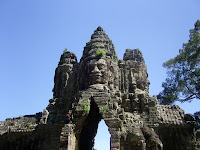
I am always excited to receive visitors from the US, because it gives me a chance to show off Singapore a little and also visit places I have not seen yet. I was doubly excited when my friend Claire came over for a two-week stint in and around Singapore. Claire and I have known each other since our time in Washington working for Senator Bentsen. It was her first trip to Asia, and I had planned a full itinerary.
I gave her a full day to get acclimated to the weather and time change, and then we stepped on a bus to head up the road to Kuala Lumpur in Malaysia. I had only visited KL for one night last year. I enjoyed it but did not know the city well. On that occasion, I took the train, going up and returning on consecutive days. I spent more time on the train than I did in the city. This time, we would take the bus – or coach, as they call it here. It would still allow us to see some of the countryside and would get us to KL a couple of hours faster than the train (five rather than seven hours). We could have taken a forty-five minute flight, but when you factor in the travel and waiting time at the Singapore airport and the travel time from the KL airport to the city (about 40 kilometres), the coach seemed pretty reasonable. I ended up being a nice ride, with great views of the plantations lining the highways.
Once in KL, we stayed at my old favorite, Hotel Maya. This is just across from the Petronas Towers and gives stunning views of one of the world’s tallest buildings. As I did in my previous visit, we took the trip up Menara KL (the KL Tower), this time for good night views of the city.
But, KL was just to whet our appetite. We had an early flight the next morning, for two nights in Cambodia and visits to the temples of Angkor.
I had wanted to visit Angkor Wat, the temple complex near Siem Reap, Cambodia, for months. I hadn’t found the right time to do it, but Claire’s visit was the perfect opportunity. We lucked out by finding a guide through a colleague of mine. Samreth Kao is a long-time resident of Siem Reap and was an excellent guide during our two days with him. It is clear that Sam knows and loves the many temples and complexes that dot the landscape around Siem Reap. I highly recommend him to anyone that is thinking of visiting the area, and I would be glad to pass along his contact information.

People often refer to all the temples around Siem Reap as Angkor Wat, but it really is just one of dozens of temples and old cities, built between the 6th and 13th Centuries. Angkor Wat is most iconic of the temples, even featured on Cambodia’s national flag. And it is fascinating. But, there are other complexes that are just as fascinating, and I think it important that any visitor take the time to see some of these.
We started at Angkor Thom, which was an entire city, containing temples, royal residences, towers, parade fields, and homes for thousands of residents. It is slightly northwest of Angkor Wat, which is a temple complex only. Our approach took us across the bridge over a man-made moat with representations of gods and demons in what looks like a tug of war, using a Naga, a huge snake. This is actually part of Hindu lore, the Churning of the Sea of Milk, where the gods and demons cooperated to churn the primordial ocean, using the Naga, to produce amrita, the elixir of mortality.



The gate itself if fascinating, with representations of faces carved into the stones, alongside all kinds of animals and humans. You enter the gate into what can be described as a mix of forest and meadows, divided by a road into the heart of Angkor Thom. We drove nearly to the other side of the complex to start our visit at a small Buddhist wat still in use. We witnessed families paying the monks to have them pour water over them, in hope that it will bring the good luck. Sam even told us that people will bring their scooters and have the “washed”, as well. Look closely and you will see it. It was an interesting start to our visit.

One note – the temples of Angkor were originally built as Hindu temples. Subsequent rulers, however, converted to Buddhism. Then some converted back. Today, it is a Buddhist complex, and you can see icons from both religions in many of the temples. There are even instances where Buddhist icons have been essentially erased (chiseled away) by the Hindu regime. It is a fascinating mix of both sets of beliefs.
No comments:
Post a Comment